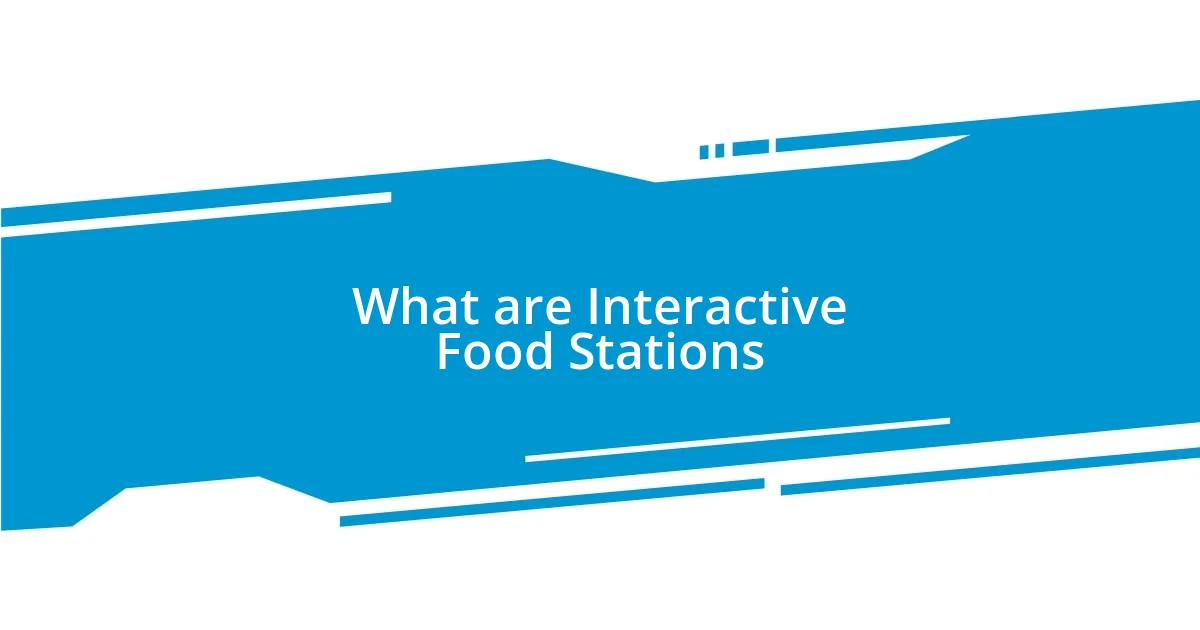Key takeaways:
- Interactive food stations foster personalization, social interaction, and memorable experiences, transforming meals into engaging gatherings.
- Types of stations, such as build-your-own burgers, dessert bars, and live cooking, create unique culinary experiences that encourage creativity and connection among guests.
- Incorporating dietary preferences enhances inclusivity and excitement, allowing all guests to participate and share in the culinary experience, regardless of their dietary restrictions.

What are Interactive Food Stations
When I think of interactive food stations, I envision vibrant setups where guests aren’t just served but actively participate in the dining experience. These stations can range from made-to-order pasta bars to gourmet taco stands, inviting everyone to customize their meals exactly how they like them. It’s a feast for the senses and the personality of the event – something truly special about crafting a dish that reflects your own taste.
I remember attending a wedding that featured a live sushi rolling station. The excitement in the air was palpable as guests took turns selecting fresh ingredients and learning from the chef while trying their hand at rolling sushi. It felt like more than just a meal; it was a chance to bond over food, share laughs, and even toast to our culinary creations. How often do we get a moment like that during a gathering?
Interactive food stations blend creativity with culinary delight, encouraging diners to explore flavors in a way that traditional buffet setups don’t. It’s that element of personalization that makes each plate unique – have you ever considered how much our choices reflect who we are? Whether you pick spicy or mild, every selection tells a story about preferences and adventures at the table.

Benefits of Interactive Food Stations
Interactive food stations bring a dynamic twist to dining, fostering an engaging atmosphere that transcends the standard experience. I’ve noticed that when people are involved in the preparation of their meals, it sparks curiosity and conversation. Just last month, at a friend’s birthday celebration, the guacamole bar set the tone for laughter and friendly debates over the ideal amount of lime juice. Guests were eagerly experimenting with ingredients, creating unique combinations, which ultimately led to a shared sense of community.
The benefits of these interactive setups are plentiful:
- Personalization: Each guest can tailor their meal, ensuring everyone is satisfied with their dish.
- Social Interaction: As people gather around food stations, they’re more likely to mingle and strike up conversations, creating a lively ambiance.
- Culinary Learning: Guests can gain new cooking skills and knowledge from chefs, enhancing their appreciation of the cuisine.
- Memorable Experiences: The involvement in cooking and the fun of trying new flavors often lead to lasting memories.
- Visual Appeal: The vibrant colors and fresh ingredients not only look inviting but can also ignite appetite and interest.
I find it rewarding to see guests come alive when they take part in creating a meal. One event I attended featured a grilled cheese station where diners could choose from an array of artisanal breads, cheeses, and toppings. Watching everyone select their favorites and share stories about how they would recreate it at home was nothing short of heartwarming. These experiences make gatherings feel meaningful, demonstrating that food is indeed a universal language.

Types of Interactive Food Stations
Interactive food stations come in many forms, each offering a unique experience. For instance, a build-your-own burger station allows guests to explore various toppings, from crispy bacon to tangy pickles, catering to every craving. I once attended a casual garden party where a burger bar was the centerpiece, and the aroma of grilled patties combined with laughter made the atmosphere incredible. It became a game to see who could create the most outrageous burger, and those playful creations made the meal unforgettable.
Another popular option is the dessert station, where guests can assemble their treats. I vividly recall a wedding featuring a sundae bar with a selection of ice creams and toppings that sparked a friendly debate about who could create the most extravagant sundae. Everyone was in high spirits, showcasing their quirky combinations, and this shared enjoyment turned into delightful conversations over bowls of creamy goodness. The laughter and playful competition created a sense of camaraderie, transforming a simple dessert into a memorable part of the event.
A more interactive choice is live cooking stations, where chefs prepare dishes right before your eyes. Watching a chef toss vegetables in a sizzling stir-fry not only engages the senses but also offers a chance for diners to learn some culinary tips firsthand. I had a fantastic experience at a friend’s anniversary party, where a delightful crepe station drew everyone in. Guests eagerly watched as fluffy crepes were made on the griddle, and they were able to customize them with fresh fruits and decadent sauces. The hospitality and expertise of the chefs sparked conversations, making it a delicious and educational evening.
| Type of Food Station | Description |
|---|---|
| Build-Your-Own Burger | Guests customize their burgers with various toppings, creating a personal culinary masterpiece. |
| Dessert Station | A hands-on dessert setup, allowing diners to assemble their own treats, like sundaes or cupcake decorations. |
| Live Cooking Stations | Chefs prepare fresh dishes on-site, offering a visual and interactive dining experience. |

Tips for Setting Up Stations
To create a captivating interactive food station, consider the layout carefully. I always find that spacing is crucial; it keeps the flow of guests moving smoothly. I once attended a picnic where the taco bar was strategically placed under a shady tree, providing a comfortable area for guests to gather without crowding around the food. You want everyone to feel welcome to explore without the pressure of a long line—wouldn’t you agree?
Another tip is to provide a clear selection of ingredients and tools. Labeling everything not only helps guests make informed choices but also adds an element of fun. At a recent event with a pasta station, I appreciated that the chef had set out sample cards beside each topping, showcasing creative flavorful pairings. It sparked curiosity—who wouldn’t want to try an unusual combination after reading how good it might taste?
Finally, consider incorporating a bit of engagement beyond just the food. I remember hosting a brunch featuring a mimosa bar, complete with a variety of juices, fresh fruits, and herbs. I had little recipes posted on each station for inspiration, turning the drink selection into an enjoyable experience. It’s those small touches that invite conversation and connection, transforming an ordinary meal into something extraordinary. What ideas do you have for encouraging that kind of interaction in your own setup?

Popular Themes for Food Stations
One theme that I find particularly fun is the international flavor station. Picture this: a vibrant taco cart showcasing different types of tortillas, fillings, and a rainbow of salsa options. At a recent fiesta-themed party I attended, guests were encouraged to taste and mix flavors from various regions, creating their unique taco masterpieces. It was thrilling to see how everyone became adventurous, experimenting with unexpected flavor combinations. Did you ever think that food could spark such curiosity and creativity among friends?
Another exciting theme is the brunch station, which allows you to serve popular breakfast favorites all day long. I experienced a delightful waffle station at a friend’s baby shower, complete with an array of toppings like whipped cream, fresh fruits, and unique syrups. Watching guests eagerly pile their plates high with luscious fillings was a joy. It felt more than just a meal; it became a shared ritual that brought everyone together, making memories over the possibility of endless waffle creations. Isn’t it amazing how food transforms even the simplest gatherings into celebrations of joy?
Then there’s the seafood bar, which I believe adds an element of elegance and adventure. I remember a networking event where a beautifully arranged oyster shucking station had guests buzzing with excitement. As chefs taught the art of shucking, the atmosphere was a mix of curiosity and laughter. The taste of fresh oysters paired with zesty lemon was truly a treat, and it sparked conversations about everyone’s experiences with seafood. Who knew that engaging with food could lead to such rich discussions and connections?

Enhancing Guest Engagement
When it comes to interactive food stations, I’ve always noticed how they naturally encourage guest engagement. For instance, during a recent holiday gathering, I found myself at a build-your-own bruschetta station. The simple act of selecting toppings created an instant camaraderie among guests as we swapped ideas and tips for the perfect combination. It was more than just filling our plates; it was a shared experience that fostered connections, laughter, and friendly debates over the best flavor pairings.
Another aspect that truly engages guests is the opportunity to learn something new while enjoying food. At an event featuring a sushi rolling station, I was captivated by how everyone gathered around, intrigued by the chef’s demonstration. As I attempted to create my own roll, I felt a rush of excitement—not only from crafting something delicious but from the collective efforts of my fellow guests sharing tips and cheering each other on. Aren’t these spontaneous moments what truly make events memorable?
Finally, I believe the element of surprise in food stations can take guest engagement to the next level. I once attended a barbecue where, to my delight, there was a DIY sliders station with a twist—unexpected toppings like kimchi and sriracha mayo. It sparked an immediate surge of creativity as we all tried to outdo one another with unique flavor combinations. Witnessing friends excitedly share their unconventional creations brought a genuine warmth to the atmosphere. Doesn’t it feel fantastic when food inspires such joyful interactions?

Incorporating Dietary Preferences
I can’t stress enough how essential it is to incorporate dietary preferences when designing interactive food stations. Recently, I was at a party that featured a plant-based station, and it was nothing short of inspiring. Guests were pleasantly surprised to see delicious options like vegan sliders and cauliflower wings, proving that flavor doesn’t have to be sacrificed for dietary needs. Each dish sparked conversations about recipes and ingredients, allowing everyone to feel included, no matter their lifestyle choices.
It’s remarkable how accommodating dietary preferences can enhance the overall experience at an event. I once experienced a gluten-free pasta bar where the options were endless. Watching friends of various dietary restrictions come together over the shared joy of building their perfect pasta dish was a heartwarming sight. It was a gentle reminder that food can bridge gaps, making people feel seen and valued. Have you ever noticed how a simple dietary inclusion can transform the mood of a gathering?
Beyond just inclusivity, I’ve found that offering diverse dietary options creates a sense of excitement. At a gathering I attended, a chef prepared a live cooking station showcasing both traditional and allergy-friendly pancakes. Guests searched for the perfect combination of toppings while discussing their preferences—who knew banana pancakes could become such a topic of discussion? By catering to everyone’s tastes, it became more than just a meal; it was a celebration of culinary creativity. Isn’t it fascinating how food can open up endless possibilities and conversations?
















